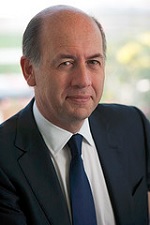 |
| Interim Sanofi CEO Serge Weinberg |
Sanofi ($SNY) execs carefully set the stage for today's pipeline review. First they rolled out a breakthrough drug designation for dupilumab, one of their top late-stage efforts, and then assembled their case that the pharma giant can break the long drought of innovation with a string of up to 18 approvals over the next 5 years. Highlighting a mix of 9 newly approved or Phase III programs, the company had no real surprises up its sleeves, but boldly promised that the rollout of new drugs had the "potential" to generate more than $38 billion in sales over the first 5 years on the market.
Investors shouldn't expect any major change in the R&D game plan set up by the recently departed CEO Chris Viehbacher, either. Sanofi says it will stay committed to Viehbacher's "open innovation" strategy, relying heavily on partners like Regeneron to produce next-gen drugs needed to keep up its revenue.
Sanofi also got an assist for today's presentation from the FDA, which just days ago reversed an earlier rejection of the multiple sclerosis drug Lemtrada, giving the drug a top place among the 9 key treatments that Sanofi is gambling on. Two other approved drugs, Cerdelga (eliglustat) and the inhaled insulin therapy Afrezza, also made the list alongside 6 top experimental meds: Praluent, their commercial name for the PCSK9 cholesterol drug alirocumab partnered with Regeneron; a combination of insulin gargline and the GLP-1 drug lixisenatide called Lixilan and Toujeo, its long-acting successor to Lantus; a dengue vaccine; and two more Regeneron partnered drugs, the rheumatoid arthritis drug sarilumab and the new 'breakthrough' treatment dupilumab.
Add it all up, promised R&D chief Elias Zerhouni, and you'll see "up to 6 new medicines in 2015 and approximately one new medicine every six months between 2016 and 2018."
Just don't expect any big spike in diabetes revenue, the company adds. Sanofi is projecting flat to minimal growth in its diabetes franchise as Lantus--the company's mainstay diabetes product--loses patients and its next-step drug Toujeo comes into play. Blockbuster Lantus sales have been essential to preventing major revenue erosion and some major rivals would like nothing better than to carve that market up among themselves.
Add it all up and investors were left in a chilly mood Thursday morning, as Sanofi's shares dropped about 3% in early trading.
More than a few analysts were left wondering this morning just how Sanofi will hit that $38 billion goal with the products at hand. But the pharma company gets points for generating some enthusiasm about its potential.
"After reviewing our model, SNY's assumed €30B sales contribution from the 2014-2020 pipeline launches looks to be substantially above our current assumption which is roughly €16B," says Leerink's Seamus Fernandez in a note to investors. "Following the recent success of the IMPROVE-IT study, we believe a 2015 approval of Praluent (PCSK9) is virtually assured and today's announcement that dupilumab (anti-IL4α) rec'd FDA Breakthrough Designation adds to the momentum of the REGN (OP) partnership."
If they do make it, they'll have Chris Viehbacher to thank. But they won't say so. There's no love lost between Weinberg and Viehbacher at this point. Weinberg's relationship with Viehbacher had gone into the deep freeze before the board ousted its CEO. And Weinberg made it clear in today's presentation that the credit for the R&D strategy belongs to the board, not Viehbacher.
"These potential launches affirm Sanofi's strategy, which has been in place since 2008, and clearly demonstrate the strong momentum of Sanofi's R&D pipeline," said Chairman and interim CEO Serge Weinberg in a statement. "As we move into this period of successive new product launches, we are investing in launch excellence and execution while continuing to fuel innovation to grow our existing pipeline."
- here's the release (PDF)